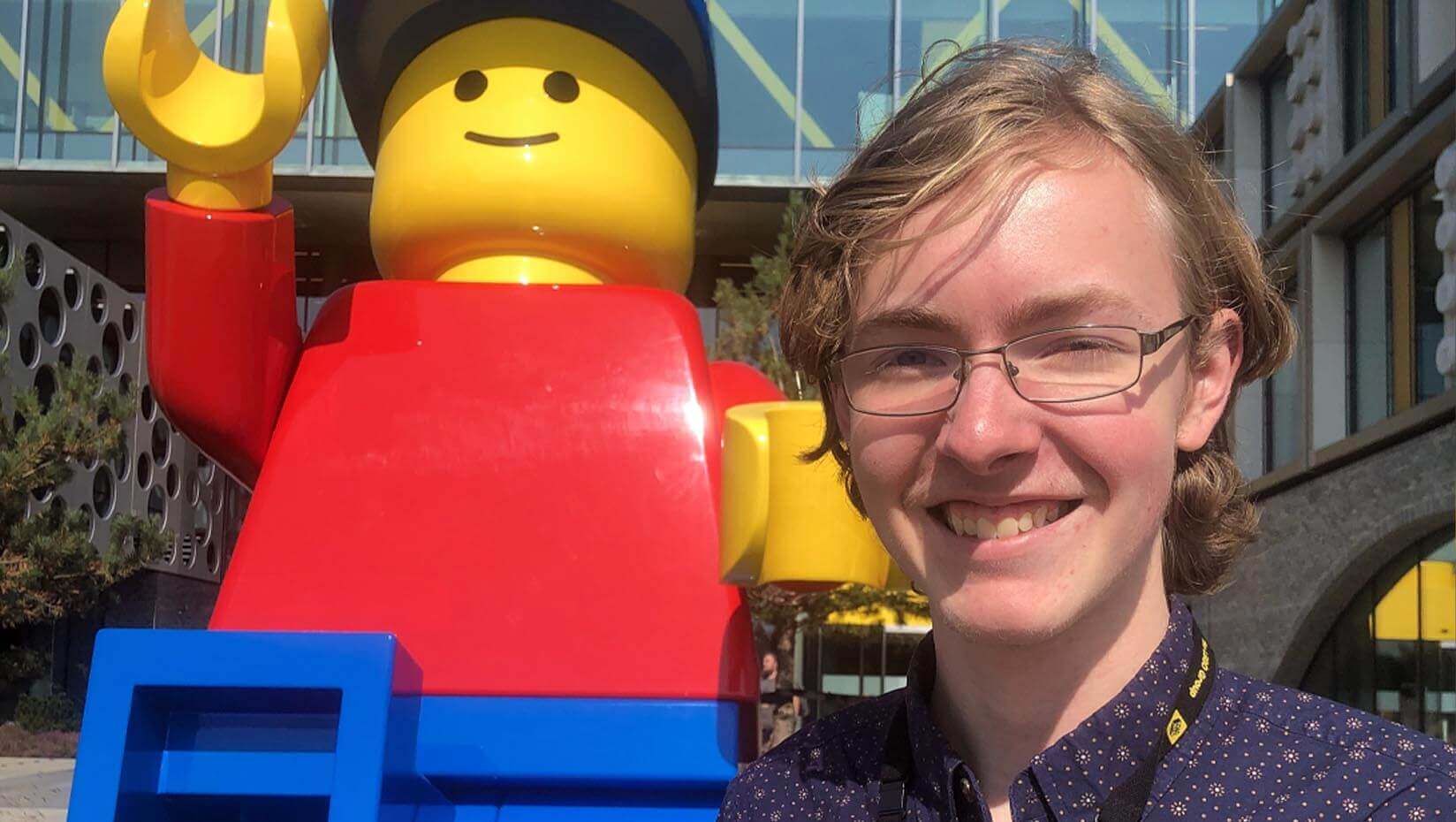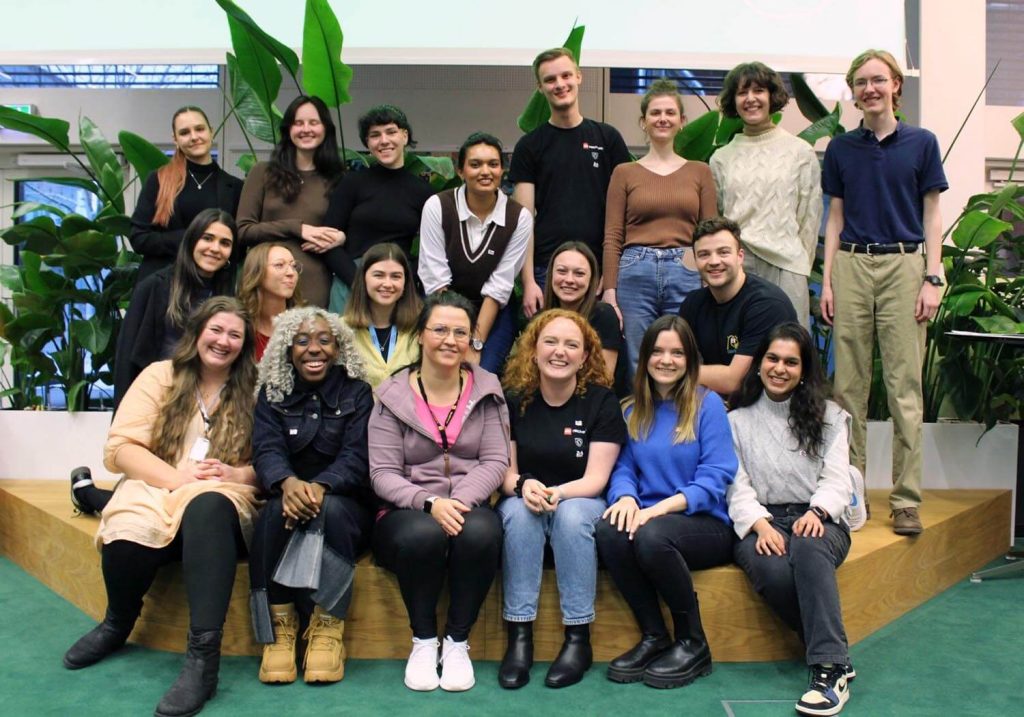
Owen Libby: Longtime LEGO lover builds dream internship
A courtyard statue of a LEGO minifigure was Owen Libby’s first impression of the time he would spend in Billund, Denmark. Past the statue, he walked into a concrete building adorned with massive toy-like bricks on the walls, roof and entryway. Inside was a towering atrium and green spiral staircase connecting four floors filled with offices and workshops.
Like walking into a fantasy, Libby had started his dream internship with the company behind his favorite childhood toys: The LEGO Group.
During the first day of his internship, Libby, a junior at the University of Maine, and 18 other interns were introduced to the headquarters of the company, LEGO Campus, before going to Innovation House, the headquarters of LEGO Design. There, they witnessed artistic designers and engineers creating the company’s upcoming products and toured the massive stock where millions of LEGO bricks resided. Pieces were divided by brick type and color in numerous boxes atop aisle shelves. Libby marveled at the extensive collection, which featured every brick currently used in LEGO products, pieces no longer in circulation and some yet to be released.
“One of my coworkers a couple of weeks later said ‘Oh yeah, when you first got here, I could see you floating a couple inches off the ground,’” Libby said. “That’s how it is for a lot of people like me who are huge LEGO fans who get to go have this dream job of actually working for the company.”
Growing up in Bow, New Hampshire, Libby collected and built hundreds of LEGO sets and designed many of his own using the bricks. Recreation aside, he has been preparing for a job at The LEGO Group since middle school.

Libby received his first LEGO set when he was six years old — inspired by one of his favorite franchises: Harry Potter. The set, “Freeing Dobby,” included bricks for a small archway and three minifigures depicting characters from a final scene in “Harry Potter and the Chamber of Secrets,” in which the titular character liberates Dobby the house-elf from the evil Lucius Malfoy.
Years later, in the halls of the company he loves, Libby was assigned to the LEGO Harry Potter design team and worked on projects that may become available for sale in the next couple of years. His mentor, George Gilliatt, previously designed models including “Dobby the House Elf” and “Gringotts Wizarding Bank – Collectors’ Edition.” Libby also worked alongside Bjarke Lykke Madsen, the creator of his favorite childhood set: the 2010 edition of Hogwarts Castle.
“For a large portion of my life up into mid-high school, the biggest thing to me was Harry Potter. I started a club at school for Harry Potter, and we did trivia and all kinds of things. The principal at the high school would literally come up to me randomly and ask Harry Potter trivia that he thought no one could answer, and I would answer it,” Libby says. “I was thrilled to be on the LEGO Harry Potter team!”
The company tasked Libby with creating concept models for potential products both individually and as part of an international team. Libby said the professional designers he worked with are titans in their industry, but also down-to-earth.
Given his background as a mechanical engineering student, they often assigned him sets with a degree of functionality, like something falling, flipping or rotating with the press of a button or pull of a lever. He built concept models both with physical bricks and digital software created for LEGO designers. The program, called LEGO Digital Designer, features assets of every piece in every available color and calculates the cost to produce a model in real life.
The internship taught Libby how to design on a budget and create sets for a target audience, whether it’s children or adults.
“The kids are going to want a lot of play features and things like that over super extreme details, whereas the adults will want ones that you can put on a shelf and which will look gorgeous, but which might be a lot more difficult to build because of all those little details,” he said.
Libby made every curricular and extracurricular decision based on how it would prepare him for working for The LEGO Group. He took engineering classes in high school, as well as robotics, 3D modeling and 3D printing. He chose to study mechanical engineering in college because it is a common field chosen by other LEGO designers. He even decided to attend UMaine partly because its clubs, specifically the 3D Printing Club, would give him the skills to pursue his dream career.
“I was vice president of 3D Printing Club, and with Black Bear Robotics Club I help at VEX Robotics events and stuff like that through the university. Having that on my resume and being able to show those extracurriculars and those leadership skills really helped,” he said.
When Libby and his family were exploring various internship opportunities for him, his mother happened upon a posting from The LEGO Group on a job search website. They found that he not only met all the qualifications but that it was exactly the position he had been waiting for. At the same time, his technical communication course assigned the making of a curriculum vitae and cover letter, which he used to apply. After two interviews, LEGO Design offered him the job.
“My people leader said that they saw my enthusiasm in the interview and saw how motivated I was, and they could tell just how much I wanted that one position and how much I’d done for it.” Libby said. “If you put in all of your time, all of your effort and you really strive for your goal, people will recognize that and you’re gonna have so much of a higher chance of actually achieving it.”
Once he graduates from UMaine, Libby plans to either pursue a graduate degree or enter the workforce. Regardless of his next steps, he intends to find his way back to working for his favorite company.
Contact: Marcus Wolf, 207.581.3721; marcus.wolf@maine.edu
